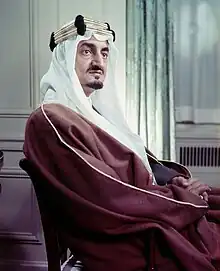Tarfa bint Abdullah Al Sheikh
Tarfa bint Abdullah Al Sheikh (Arabic: طرفة بنت عبد الله آل الشيخ, romanized: Ṭarfā bint ʿAbd Allāh Al ash Sheikh; 1884–1906) was one of the spouses of Abdulaziz bin Abdul Rahman, Emir of Nejd (later King Abdulaziz of Saudi Arabia), and the mother of Princess Noura and King Faisal.[1][2]
| Tarfa bint Abdullah Al Sheikh | |||||
|---|---|---|---|---|---|
| Born | 1884 | ||||
| Died | October 1906 (aged 21–22) | ||||
| Spouse | |||||
| Issue |
| ||||
| |||||
| House | |||||
| Father | Abdullah bin Abdullatif Al Sheikh | ||||
| Mother | Haya bint Abdul Rahman Al Muqbel | ||||
Background and early life

Tarfa bint Abdullah Al Sheikh was born in 1884.[3] Her mother was Haya bint Abdul Rahman Al Muqbel.[4] Her family were from a village near Riyadh.[5]
Tarfa's father, Abdullah bin Abdullatif Al Sheikh, was a member of the Al Sheikh family and one of the principal religious teachers and advisers to the Emir of Nejd, Abdulaziz bin Abdul Rahman.[6][7] However, until Emir Abdulaziz captured Riyadh, Abdullah was a supporter of Emir Muhammad bin Abdullah Al Rashid.[6] Tarfa was one of Muhammad ibn Abd al-Wahhab's eighth generation direct descendants.[8][9]
Personal life and death
Tarfa bint Abdullah married Emir Abdulaziz in 1902 immediately after he captured Riyadh.[4][10] She was his third wife.[11] Tarfa's sister Munira married Abdulaziz's half-brother Muhammad bin Abdul Rahman,[12] and her other sister, Sara, married Abdulaziz's full-brother Saad bin Abdul Rahman.[5][8] These marriages were strategic moves to strengthen the links between the Al Sauds and the Al Sheikhs.[13][14]
Abdulaziz and Tarfa's first child, Noura, was born in 1904. Their son, Faisal, was born in Riyadh in April 1906.[5][7][15] Tarfa died in October 1906 when Faisal was just six months old.[4][15] Her daughter Noura married a cousin, Khalid bin Muhammad, son of Muhammad bin Abdul Rahman.[16] Tarfa's son Faisal would become king of Saudi Arabia in 1964.[5]
Ancestry
| Ancestors of Tarfa bint Abdullah Al Sheikh | ||||||||||||||||||||||||||||||||||||||||||||||||||||||||||||||||||||||||||||||||||||||||||||||||||||||||||||||
|---|---|---|---|---|---|---|---|---|---|---|---|---|---|---|---|---|---|---|---|---|---|---|---|---|---|---|---|---|---|---|---|---|---|---|---|---|---|---|---|---|---|---|---|---|---|---|---|---|---|---|---|---|---|---|---|---|---|---|---|---|---|---|---|---|---|---|---|---|---|---|---|---|---|---|---|---|---|---|---|---|---|---|---|---|---|---|---|---|---|---|---|---|---|---|---|---|---|---|---|---|---|---|---|---|---|---|---|---|---|---|
| ||||||||||||||||||||||||||||||||||||||||||||||||||||||||||||||||||||||||||||||||||||||||||||||||||||||||||||||
References
- Brian Lees (2006). "The Al Saud family and the future of Saudi Arabia". Asian Affairs. 37 (1): 45. doi:10.1080/03068370500457411. S2CID 162227738.
- Mai Yamani (January–March 2009). "From fragility to stability: a survival strategy for the Saudi monarchy". Contemporary Arab Affairs. 2 (1): 91. doi:10.1080/17550910802576114.
- "طرفة بنت عبد الله بن عبد اللطيف آل الشيخ". Kachaf (in Arabic). Retrieved 20 September 2020.
- "في ذكري ميلاده.. تعرف على أهم أسرار حياة الملك فيصل آل سعود". Elzman News (in Arabic). 14 April 2020. Retrieved 20 September 2020.
- Alexei Vassiliev (2013). King Faisal: Personality, Faith and Times. London: Saqi. pp. 7, 12. ISBN 978-0-86356-761-2.
- Alexander B. Bligh (1985). "The Saudi religious elite (Ulama) as participant in the political system of the kingdom". International Journal of Middle East Studies. 17: 37–50. doi:10.1017/S0020743800028750. S2CID 154565116.
- Bernard Reich, ed. (1990). Political Leaders of the Contemporary Middle East and North Africa: A Biographical Dictionary. New York: Greenwood Press. p. 180. ISBN 978-0-313-26213-5.
- Alexander Blay Bligh (1981). Succession to the throne in Saudi Arabia. Court Politics in the Twentieth Century (PhD thesis). Columbia University. pp. 42, 48. ProQuest 303101806.
- "File 11/44 Leading Personalities in Iraq, Iran & Saudi Arabia". Qatar Digital Library. 13 January 1948. Retrieved 18 August 2023.
Citing from the British India Office Records and Private Papers
- Madawi Al Rasheed (2002). A History of Saudi Arabia. Cambridge: Cambridge University Press. p. 78. ISBN 978-0-521-64412-9.
- Henri Lauzière (2000). On the Origins of Arab Monarchy: Political Culture, Historiography, and the Emergence of the Modern Kingdoms in Morocco and Saudi Arabia (PDF) (MA thesis). Simon Fraser University. p. 34.
- Prince Mohammed bin Abdul Rahman Al Faisal Al Saud (PDF). Prince Mohammed bin Abdul Rahman and Family Charitable Organization. p. 55. Archived from the original (PDF) on 17 September 2012.
- Alejandra Galindo Marines (2001). The relationship between the ulama and the government in the contemporary Saudi Arabian Kingdom: an interdependent relationship? (PDF) (PhD thesis). Durham University.
- Dhaifallah Alotaibi (2017). Ibn Sa'ud and Britain: Early Changing Relationship and Pre-state Formation 1902-1914 (PhD thesis). Bangor University. p. 58. ProQuest 2083742545.
- "King Faisal and His Family". King Faisal Center for Research and Islamic Studies. Retrieved 20 September 2020.
- As'ad AbuKhalil (2004). The Battle for Saudi Arabia. Royalty, fundamentalism and global power. New York City: Seven Stories Press. p. 9. ISBN 1-58322-610-9.